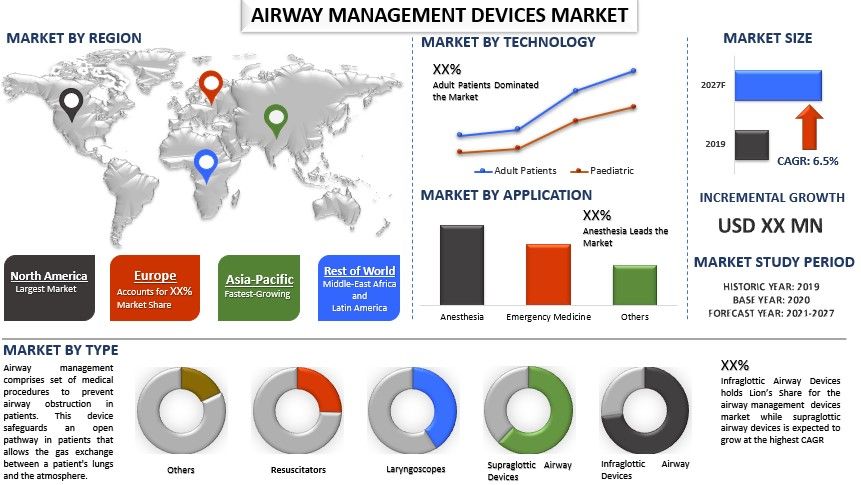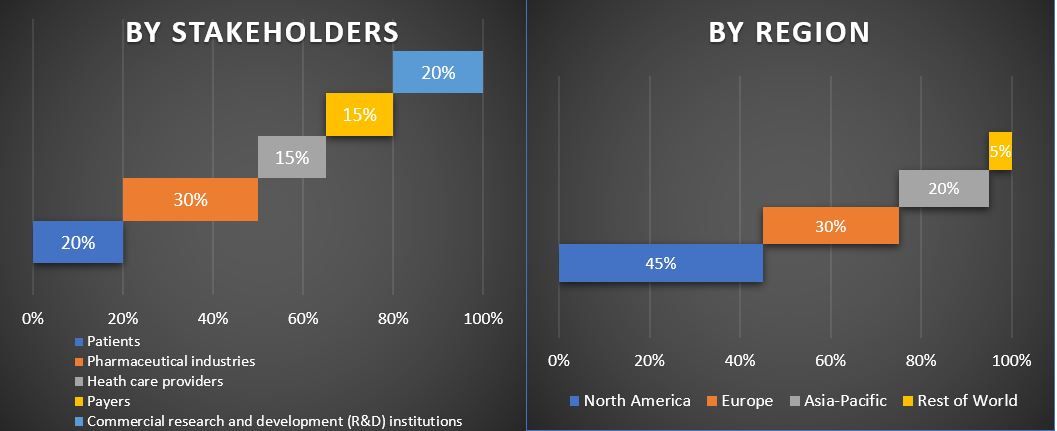- Home
- About Us
- Industry
- Services
- Reading
- Contact Us
Airway Management Devices Market: Current Analysis and Forecast (2021-2027)
Emphasis on Type (Infraglottic Airway Management Devices, Supraglottic Airway Management Devices, Laryngoscopes, Resuscitators, Others); Patient Age (Adult Patients, Pediatric/Neonatal Patients); Application (Anesthesia, Emergency Medicine, Others); End-User (Hospitals, Ambulatory Care Settings, Home Care Settings, Others); Region and Country

Airway Management Devices Market was valued at US$ 1.5 billion in 2020 and is expected to grow at a CAGR of 6% over the forecast period (2021-2027). The demand for Airway Management Devices Market is increasing on account of increasing prevalence of respiratory diseases such as Asthma and COPD cases, rise in the aging population, increase in urbanization and pollution, growing investments in healthcare infrastructure, favourable reimbursement coverage across developed countries, increase in the preterm birth cases, and lifestyle changes. According to the WHO estimates, 65 million people suffer from moderate-to-severe COPD. Moreover, COPD is predicted to be the third leading cause of death worldwide. In addition to the abovementioned factors, increasing need for emergency treatment for prolonged illnesses as well as protracted treatments associated with lung diseases in children and adults is serving as a huge opportunity.
Patients suffering from infectious, chronic, and cardiac conditions often experience airway complications, which require immediate treatment. According to the 2019 health data of CDC, the number of emergency department visits among adults aged 18 years and above in the US has increased by about 8.67% during 1997-2018.
Airway management comprises set of medical procedures to prevent airway obstruction in patients. This device safeguards an open pathway in patients that allows the gas exchange between a patient’s lungs and the atmosphere. There are various products such as oropharyngeal airway, nasopharyngeal airways, laryngeal mask airways and tracheal incubation which are used in providing airway in patients undergoing anesthesia procedures in hospitals. These devices are widely used in fields of anesthesia, cardiopulmonary resuscitation, emergency medicine, neonatology, and many others. In neonatology it has application for managing airway among babies and increasing incidence of preterm birth may require the need of airway management. For instance, according to World Health Organization, stated in 2018, approximately 15 million preterm babies are born each year (before 37 weeks of gestation), which is more than 1 out of 10 infants and this number is increasing per year. In 184 nations, preterm birth rates vary from 5% to 18% of infants born. Increase in preterm birth worldwide is one of the major factors in driving the market.
National Asthma Prevalence (%), 2019
Though asthma prevalence cases are higher in children, mortality, and morbidity, cases are higher in adults. Moreover, the childhood asthma cases are more in boys whereas the adult asthma cases are more in women. As per the data shared by national and state surveillance systems administered by the Centers for Disease Control and Prevention (CDC), the young teens of 12-14 years old mostly suffers from a high prevalence of Asthma attacks.
Medtronic Plc, Smiths Medical (Smiths Group Plc), Teleflex Inc, Ambu A/S, Convatec Group, Karl Storz Se & Co. Kg, Flexicare, Intersurgical, Sunmed and Vyaire Medical Inc. are some of the prominent players operating in the global Airway Management Devices market. Several M&A’s along with partnerships have been undertaken by these players to develop new and advanced airway management devices products.
Insights Presented in the Report
“Amongst type, Infraglottic Airway Management Devices segment holds the major share”
Based on type the global Airway Management Devices Market is segmented into Infraglottic Airway Management Devices, Supraglottic Airway Management Devices, Laryngoscopes, Resuscitators, and Others. Currently, Infraglottic devices segment is expected to dominate the market by holding largest market share during the forecast period. Surging demand for positive air pressure ventilation among the patients facing respiratory failure is driving the demand for intubation, thereby contributing to the growth of this segment. The Infraglottic devices such as endotracheal tubes and tracheostomy tubes are used during intubation for rescuing airway and provide ventilation after connecting with external breathing assistance systems.
“Amongst patient age, Adult Patients segment holds the major share”
By patient age, the global Airway Management Devices Market is segmented into Adult Patients and Pediatric/Neonatal Patients. Adult segment is dominating the market. The growing adult population and the increase in the occurrence of chronic diseases in geriatric patients are the key factors contributing for the of adult patients age segment. According to the Centers for Disease Control and Prevention (CDC), in 2015, total number of the emergency department visit with the chronic diseases in the U.S. are Chronic obstructive pulmonary disease (COPD) 7,251, Congestive heart failure 4,413 Hypertension 32,370 per thousand patients.
“Amongst application, the Anesthesia segment holds the major share”
In terms of application, the market is grouped into Anesthesia, Emergency Medicine and Others. Among them, the anesthesia segment is forecasted to lead the market share during the forecast period. This can be ascribed to the increasing growth in the number of surgical interventions globally, that require the patients to be provided with anesthesia.
“Amongst end-user, the Hospitals segment holds the major share”
Based on end-user the market is categorized into Hospitals, Ambulatory Care Settings, Home Care Settings and Others. At present, hospital segment dominates the market and is expected to maintain its dominance during the analyzed period as well. This supremacy is ascribed to growing rising number of hospitals and infrastructural & economic development, especially in emerging countries. In addition to this, increase in surgical procedures performed-where airway management devices are used for ventilation, oxygenation, and the administration of anesthesia-also supports high growth in the hospitals segment. As per the Pan American Health Organization, 75% of all hospitalized patients require supplemental oxygen treatment.
“North America signifies one of the largest markets of Airway Management Devices Market”
For a better understanding of the market dynamics of the Airway Management Devices market, a detailed analysis was conducted for different regions across the globe including North America (United States, Canada, and the Rest of North America), Europe (Germany, France, Italy, Spain, United Kingdom and Rest of Europe), Asia-Pacific (China, Japan, India, South Korea, and Rest of APAC), Rest of World has been conducted. North America dominated the market and generated revenue of USD XX million in 2020 which is attributable to the presence of a highly developed healthcare system, the increasing number of healthcare settings, the rising prevalence of chronic respiratory diseases, the significant number of prominent vendors, and favorable reimbursement policies for airway management devices in the region. At the same time, Asia-Pacific is anticipated to grow at the highest CAGR of XX% during the forecast period.
Reasons to buy this report:
- The study includes market sizing and forecasting analysis validated by authenticated key industry experts
- The report presents a quick review of overall industry performance at one glance
- The report covers an in-depth analysis of prominent industry peers with a primary focus on key business financials, product portfolio, expansion strategies, and recent developments
- Detailed examination of drivers, restraints, key trends, and opportunities prevailing in the industry
- The study comprehensively covers the market across different segments
- Deep dive regional level analysis of the industry
Customization Options:
The Airway Management Devices market can further be customized as per the requirement or any other market segment. Besides this, UMI understands that you may have your own business needs, hence feel free to connect with us to get a report that completely suits your requirements.
Table of Content
Analyzing the historical market, estimation of the current market, and forecasting the future market of the Global Airway Management Devices Market were the three major steps undertaken to create and analyze the adoption of Airway Management Devices for the different diseases across major regions globally. Exhaustive secondary research was conducted to collect the historical market numbers and estimate the current market size. Secondly, to validate these insights, numerous findings and assumptions were taken into consideration. Moreover, exhaustive primary interviews were also conducted, with industry experts across the value chain of Airway Management Devices. Post assumption and validation of market numbers through primary interviews, we employed a top-down approach to forecast the complete market size. Thereafter, market breakdown and data triangulation methods were adopted to estimate and analyze the market size of segments and sub-segments the industry pertains to. Detailed methodology is explained below:
Analysis of Historical Market Size
Step 1: In-Depth Study of Secondary Sources:
Detailed secondary study was conducted to obtain the historical market size of the Airway Management Devices market through company internal sources such as annual report & financial statements, performance presentations, press releases, etc., and external sources including journals, news & articles, government publications, competitor publications, sector reports, third-party database, and other credible publications.
Step 2: Market Segmentation:
After obtaining the historical market size of the Airway Management Devices market, we conducted a detailed secondary analysis to gather historical market insights and share for different segments for major regions. Major segments included in the report are product and end-user. Further country-level analyses were conducted to evaluate the overall utilization of Airway Management Devices in every region.
Step 3: Factor Analysis:
After acquiring the historical market size of different segments and sub-segments, we conducted a detailed factor analysis to estimate the current market size of Airway Management Devices market. Further, we conducted factor analysis using dependent and independent variables such as high prevalence of asthma and chronic obstructive pulmonary diseases (COPDs). A thorough analysis was conducted for demand and supply-side scenario considering top partnerships, merger and acquisition, business expansion, and product launches in the Airway Management Devices industry across the globe.
Current Market Size Estimate & Forecast
Current Market Sizing: Based on actionable insights from the above 3 steps, we arrived at the current market size, key players in the Airway Management Devices market, and market shares of the segments. All the required percentage shares split, and market breakdowns were determined using the above-mentioned secondary approach and were verified through primary interviews.
Estimation & Forecasting: For market estimation and forecast, weights were assigned to different factors including drivers & trends, restraints, and opportunities available for the stakeholders. After analyzing these factors, relevant forecasting techniques i.e. top-down/bottom-up approach was applied to arrive at the market forecast about 2027 for different segments and subsegments across the major markets globally. The research methodology adopted to estimate the market size encompasses:
- The industry’s market size, in terms of value (USD) and the utilization rate of Airway Management Devices across the major markets domestically
- All percentage shares, splits, and breakdowns of market segments and sub-segments
- Key players in the Airway Management Devices market in terms of services offered. Also, the growth strategies adopted by these players to compete in the fast-growing market
Market Size and Share Validation
Primary Research: In-depth interviews were conducted with the Key Opinion Leaders (KOLs) including Top Level Executives (CXO/VPs, Sales Head, Marketing Head, Operational Head, and Regional Head, Country Head, etc.) across major regions. Primary research findings were then summarized, and statistical analysis was performed to prove the stated hypothesis. Inputs from primary research were consolidated with secondary findings, hence turning information into actionable insights.
Split of Primary Participants in Different Regions
Market Engineering
Data triangulation technique was employed to complete the overall market estimation and to arrive at precise statistical numbers of each segment and sub-segment of the Airway Management Devices market. Data was split into several segments & sub-segments post studying various parameters and trends in the areas of type, patient age, application, and end user of the Airway Management Devices market.
Main Objective of the Airway Management Devices Market Study
The current & future market trends of Airway Management Devices were pinpointed in the study. Investors can gain strategic insights to base their discretion for investments from the qualitative and quantitative analysis performed in the study. Current and future market trends were determined the overall attractiveness of the market at a regional level, providing a platform for the industrial participant to exploit the untapped market to benefit as a first-mover advantage. Other quantitative goals of the studies include:
- Analyze the current and forecast market size of Airway Management Devices in terms of value (USD). Also, analyze the current and forecast market size of different segments and sub-segments
- Segments in the study include areas of type, patient age, application, and end user
- Define and analysis of the regulatory framework for the Airway Management Devices industry
- Analyze the value chain involved with the presence of various intermediaries, along with analyzing customer and competitor behaviors of the industry
- Analyze the current and forecast market size of the Airway Management Devices market for the major region
- Major regions studied in the report include North America (United States, Canada, and the Rest of North America), Europe (Germany, France, Italy, Spain, United Kingdom and Rest of Europe), Asia-Pacific (China, Japan, India, South Korea, and Rest of APAC), and Rest of the World
- Company profiles of the Airway Management Devices market and the growth strategies adopted by the market players to sustain in the fast-growing market
- Deep dive regional level analysis of the industry
Related Reports
Customers who bought this item also bought












